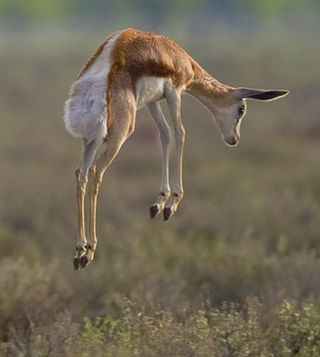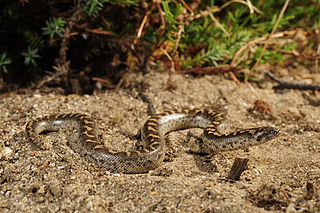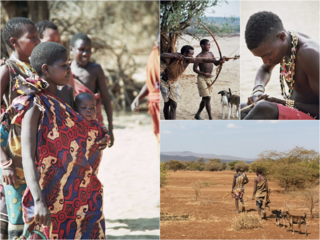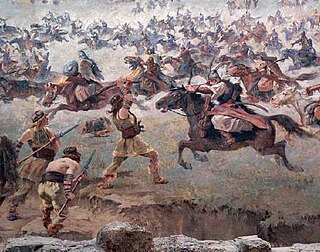Related Research Articles

Evolutionary psychology is a theoretical approach in psychology that examines cognition and behavior from a modern evolutionary perspective. It seeks to identify human psychological adaptations with regards to the ancestral problems they evolved to solve. In this framework, psychological traits and mechanisms are either functional products of natural and sexual selection or non-adaptive by-products of other adaptive traits.

The Paleolithic or Palaeolithic, also called the Old Stone Age, is a period in human prehistory that is distinguished by the original development of stone tools, and which represents almost the entire period of human prehistoric technology. It extends from the earliest known use of stone tools by hominins, c. 3.3 million years ago, to the end of the Pleistocene, c. 11,650 cal BP.

A traditional hunter-gatherer or forager is a human living an ancestrally derived lifestyle in which most or all food is obtained by foraging, that is, by gathering food from local sources, especially edible wild plants but also insects, fungi, honey, or anything safe to eat, and/or by hunting game, roughly as most animal omnivores do. Hunter-gatherer societies stand in contrast to the more sedentary agricultural societies, which rely mainly on cultivating crops and raising domesticated animals for food production, although the boundaries between the two ways of living are not completely distinct.
Concealed ovulation or hidden estrus in a species is the lack of any perceptible change in an adult female when she is fertile and near ovulation. Some examples of perceptible changes are swelling and redness of the genitalia in baboons and bonobos, and pheromone release in the feline family. In contrast, the females of humans and a few other species that undergo hidden estrus have few external signs of fecundity, making it difficult for a mate to consciously deduce, by means of external signs only, whether or not a female is near ovulation.

Within evolutionary biology, signalling theory is a body of theoretical work examining communication between individuals, both within species and across species. The central question is when organisms with conflicting interests, such as in sexual selection, should be expected to provide honest signals rather than cheating. Mathematical models describe how signalling can contribute to an evolutionarily stable strategy.

The grandmother hypothesis is a hypothesis to explain the existence of menopause in human life history by identifying the adaptive value of extended kin networking. It builds on the previously postulated "mother hypothesis" which states that as mothers age, the costs of reproducing become greater, and energy devoted to those activities would be better spent helping her offspring in their reproductive efforts. It suggests that by redirecting their energy onto those of their offspring, grandmothers can better ensure the survival of their genes through younger generations. By providing sustenance and support to their kin, grandmothers not only ensure that their genetic interests are met, but they also enhance their social networks which could translate into better immediate resource acquisition. This effect could extend past kin into larger community networks and benefit wider group fitness.

Parental investment, in evolutionary biology and evolutionary psychology, is any parental expenditure that benefits offspring. Parental investment may be performed by both males and females, females alone or males alone. Care can be provided at any stage of the offspring's life, from pre-natal to post-natal.

A pack hunter or social predator is a predatory animal which hunts its prey by working together with other members of its species. Normally animals hunting in this way are closely related, and with the exceptions of chimpanzees where only males normally hunt, all individuals in a family group contribute to hunting. When hunting cooperation is across two or more species, the broader term cooperative hunting is commonly used.

A psychological adaptation is a functional, cognitive or behavioral trait that benefits an organism in its environment. Psychological adaptations fall under the scope of evolved psychological mechanisms (EPMs), however, EPMs refer to a less restricted set. Psychological adaptations include only the functional traits that increase the fitness of an organism, while EPMs refer to any psychological mechanism that developed through the processes of evolution. These additional EPMs are the by-product traits of a species’ evolutionary development, as well as the vestigial traits that no longer benefit the species’ fitness. It can be difficult to tell whether a trait is vestigial or not, so some literature is more lenient and refers to vestigial traits as adaptations, even though they may no longer have adaptive functionality. For example, xenophobic attitudes and behaviors, some have claimed, appear to have certain EPM influences relating to disease aversion, however, in many environments these behaviors will have a detrimental effect on a person's fitness. The principles of psychological adaptation rely on Darwin's theory of evolution and are important to the fields of evolutionary psychology, biology, and cognitive science.

The Hadza, or Hadzabe, are a protected Hunter-gatherer Tanzanian indigenous ethnic group from Baray ward in southwest Karatu District of Arusha Region. They live around Lake Eyasi basin in the central Rift Valley and in the neighboring Serengeti Plateau. There are, as of 2015, between 1,200 and 1,300 Hadza people living in Tanzania, however only around 400 Hadza still survive exclusively based on the traditional means of foraging. Additionally, the increasing impact of tourism and encroaching pastoralists pose serious threats to the continuation of their traditional way of life.
Extra-pair copulation (EPC) is a mating behaviour in monogamous species. Monogamy is the practice of having only one sexual partner at any one time, forming a long-term bond and combining efforts to raise offspring together; mating outside this pairing is extra-pair copulation. Across the animal kingdom, extra-pair copulation is common in monogamous species, and only a very few pair-bonded species are thought to be exclusively sexually monogamous. EPC in the animal kingdom has mostly been studied in birds and mammals. Possible benefits of EPC can be investigated within non-human species, such as birds.

Mate choice is one of the primary mechanisms under which evolution can occur. It is characterized by a "selective response by animals to particular stimuli" which can be observed as behavior. In other words, before an animal engages with a potential mate, they first evaluate various aspects of that mate which are indicative of quality—such as the resources or phenotypes they have—and evaluate whether or not those particular trait(s) are somehow beneficial to them. The evaluation will then incur a response of some sort.
The patriarch hypothesis is a hypothesis that explains the occurrence of menopause in human females and how a long post-fertile period could confer an evolutionary advantage. It is an alternative theory to the grandmother hypothesis which tends to ignore male benefits of continued spermatogenesis and their roles in assistance.
The sexual division of labour (SDL) is the delegation of different tasks between males and females. Among human foragers, males and females target different types of foods and share them with each other for a mutual or familial benefit. In some species, males and females eat slightly different foods, while in other species, males and females will routinely share food; but only in humans are these two attributes combined. The few remaining hunter-gatherer populations in the world serve as evolutionary models that can help explain the origin of the sexual division of labor. Many studies on the sexual division of labor have been conducted on hunter-gatherer populations, such as the Hadza, a hunter-gatherer population of Tanzania.
The origins of society — the evolutionary emergence of distinctively human social organization — is an important topic within evolutionary biology, anthropology, prehistory and palaeolithic archaeology. While little is known for certain, debates since Hobbes and Rousseau have returned again and again to the philosophical, moral and evolutionary questions posed.
Mate preferences in humans refers to why one human chooses or chooses not to mate with another human and their reasoning why. Men and women have been observed having different criteria as what makes a good or ideal mate. A potential mate's socioeconomic status has also been seen as having a noticeable effect, especially in developing areas where social status is more emphasized.
The gathering hypothesis is a term in evolutionary psychology coined in 1970s feminism as the antithesis of "hunting hypothesis", suggesting that gathering rather than hunting was the main factor in the emergence of anatomically modern humans.

The male warrior hypothesis (MWH) is an evolutionary psychology hypothesis by Professor Mark van Vugt which argues that human psychology has been shaped by between-group competition and conflict. Specifically, the evolutionary history of coalitional aggression between groups of men may have resulted in sex-specific differences in the way outgroups are perceived, creating ingroup vs. outgroup tendencies that are still observable today.
Evolutionary biologists have developed various theoretical models to explain the evolution of food-sharing behavior—"[d]efined as the unresisted transfer of food" from one food-motivated individual to another—among humans and other animals.

Costly signaling theory in evolutionary psychology refers to uses of costly signaling theory and adaptationism in explanations for psychological traits and states. Often informed by the closely related fields of human behavioral ecology and cultural evolution, such explanations are predominantly focused on humans and emphasize the benefits of altering the perceptions of others and the need to do so in ways that are difficult to fake due to the widespread existence of adaptations which demand reliable information to avoid manipulation through dishonest signals.
References
- ↑ Buss, David (1999). Evolutionary Psychology: The new Science of the Mind. New York: Needham Heights: Allyn & Bacon.
- 1 2 3 4 5 6 7 8 9 10 11 Buss, David M. Evolutionary Psychology: The New Science of the Mind. Boston: Allyn & Bacon, 2011. Print. 80
- 1 2 3 4 5 Haas, Randall; Watson, James; Buonasera, Tammy; Southon, John; Chen, Jennifer C.; Noe, Sarah; Smith, Kevin; Llave, Carlos Viviano; Eerkens, Jelmer; Parker, Glendon (2020-11-06). "Female hunters of the early Americas". Science Advances. 6 (45): eabd0310. Bibcode:2020SciA....6..310H. doi:10.1126/sciadv.abd0310. ISSN 2375-2548. PMC 7673694 . PMID 33148651.
- 1 2 3 4 5 6 7 8 9 10 11 12 13 Kelly, Robert L. (2013). The lifeways of hunter-gatherers : the foraging spectrum. Robert L. Kelly (2nd ed.). Cambridge. ISBN 978-1-107-34172-2. OCLC 836848791.
- 1 2 3 4 5 6 7 8 9 10 11 12 13 14 M., Buss, David (2019). Evolutionary psychology : the new science of the mind. Routledge. ISBN 978-1-138-08818-4. OCLC 1295429010.
- ↑ Stoet, Gisbert (2011). "Sex Differences in Search and Gathering Skills". Evolution and Human Behavior. 32 (6): 416–22. doi:10.1016/j.evolhumbehav.2011.03.001.
- 1 2 M., Buss, David (2019). Evolutionary psychology : the new science of the mind. Routledge. ISBN 978-1-138-08818-4. OCLC 1295429010.
- ↑ Meehan, Marjorie C. (1976-09-06). "The Hunting Hypothesis: A Personal Conclusion Concerning the Evolutionary Nature of Man". JAMA: The Journal of the American Medical Association. 236 (10): 1172. doi:10.1001/jama.1976.03270110068039. ISSN 0098-7484.
- 1 2 3 Nolin, David A (2010). "Food-Sharing Networks in Lamalera, Indonesia". Human Nature. 21 (3): 243–68. doi:10.1016/j.evolhumbehav.2011.11.003. PMC 3398706 . PMID 22822299.
- 1 2 3 4 5 6 7 8 9 Hawkes, Kristen (1991). "Showing Off Tests of an Hypothesis About Men's Foraging Goals". Ethology and Sociobiology. 12 (1): 29–54. doi:10.1016/0162-3095(91)90011-E.
- ↑ Larsen, Clark S. (2012). "Chapter 10: Early Hominid Origins and Evolution: The Roots of Humanity". Our Origins: Discovering Physical Anthropology. W. W. Norton & Company. ISBN 978-0-393-93498-4. OCLC 813933300.